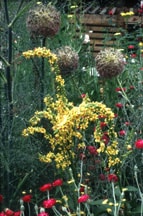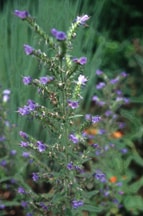 A woman came into the nursery the other day asking if we had any Lupine plants. “I have a beautiful Lupine in bloom and I want several more!” she said. Her face fell when I told her that we were sold out of this June-blooming perennial. “Why don’t you save some seeds from the plant you have now?” I asked, “You may not get the same color of flower, but you will get many more Lupine.” “Oh no,” she answered as she moved away, “I couldn’t do that.”
A woman came into the nursery the other day asking if we had any Lupine plants. “I have a beautiful Lupine in bloom and I want several more!” she said. Her face fell when I told her that we were sold out of this June-blooming perennial. “Why don’t you save some seeds from the plant you have now?” I asked, “You may not get the same color of flower, but you will get many more Lupine.” “Oh no,” she answered as she moved away, “I couldn’t do that.”
Her response was a common one. Americans, once seed-saving (and sharing) pioneers, have evolved into seed-phobic gardeners. In their desire to see a finished garden quickly, many deny themselves the pleasure of nurturing a plant from seed to bloom.
But there are signs that this may be changing. There is great interest in heirloom varieties and unusual plants, as well as a growing commitment to maintaining horticultural diversity. As greater numbers of people find joy and success in the garden, many also become interested in various methods of propagation, including seed saving.
Perhaps seed saving fell out of favor because of the large numbers of hybrid plants being offered for sale. Hybrids are often selected because they are unusual in color, earlier blooming, or more compact. But the seed saved from a hybrid usually produces plants showing the characteristics of previous generations; you don’t always get what you had before. In order to propagate plants that are identical to the parent plant and each other, you need to take seed from a species or one of the hybrids that comes true from seed.
Many gardeners find that growing plants from their own seeds is rewarding despite the occasional uncertainty of how the offspring will look. Watching how the plants develop is part of the adventure of seed saving; the appearance of an unexpected flower color (or, dare we hope, variegated foliage) is the cause of delight. Once the seeds have been germinated, the gardener can select the seedlings and plants that are the most healthy and pleasing.
Saving old or little known varieties of plants is equally satisfying. Occasionally new home-owners will find an unusual perennial growing in a long neglected garden; others are growing plants handed down from their mothers and grandmothers.
 Collecting and sharing seeds of such heirlooms insures that future generations of gardeners will be able to have the pleasure of that plant’s company. And saving seeds is quite simple to do.
Collecting and sharing seeds of such heirlooms insures that future generations of gardeners will be able to have the pleasure of that plant’s company. And saving seeds is quite simple to do.
Seeds need to be fully mature before being harvested. As flower petals wither and seed pods form and dry, monitor the plant and cut the seed heads before mature seeds blow away or fall on the ground. If you are unable to check the plant frequently, or are unsure when to pick a seedpod, tie a small piece of “bridal netting,” (available at craft and fabric stores) around the developing pods to catch your crop.
Cut seed heads should be put in a warm, dry place to cure. Lay them whole on a tray lined with paper, or inside a paper bag. If you are collecting seed from several plants, label each variety along with notes about color and collection time. If these notes are made on a peel and stick label it can be placed among the seedheads as they dry, and later used on the seeds’ envelope.
Small seeds will be dry in a week, but larger ones take two to three weeks to cure. Once fully dry, the seeds can be easily separated from the stems, pods and seed heads. Place seeds in paper envelopes and label. Small coin envelopes that are sold in office supply stores make ideal home seed packs.
Envelopes of seeds should be stored in an airtight jar or plastic carton. Adding a few packets of silica gel that have been recycled from vitamin jars, shoeboxes, or newly purchased electronics helps keep condensation from causing seeds to mold. Store the jar or carton in a cool room or in the refrigerator.
In addition to annual species such as Petunia integrifolia, Silene armeria (Sweet-William Catchfly), Nicotianna alata (Flowering Tobacco), any perennial that is known to seed itself around your garden is easy to start from collected seed. Digitalis (Foxglove), Echinacea (Purple Coneflower), Polemonium (Jacob’s Ladder), and Alchemilla (Lady’s Mantle) are a few such plants. Other perennials that are satisfying to collect from include the various Campanula varieties (Bellflower), Liatris (Gayfeather), Platycodon (balloon flower) and Hostas.
 Many people find that once they begin saving seeds they look at wilted flowers in an entirely new way. Although I encounter many folks with seed phobias, occasionally a fellow convert enters the garden center. As I collected pots of plants that were past bloom last summer, a woman tapped me on the shoulder. “Are you deadheading those Verbascum?” she asked. “Would you mind if I took the seeds?” “I’d love for you to have them.” I answered, “Let’s find a paper bag to put them in.”
Many people find that once they begin saving seeds they look at wilted flowers in an entirely new way. Although I encounter many folks with seed phobias, occasionally a fellow convert enters the garden center. As I collected pots of plants that were past bloom last summer, a woman tapped me on the shoulder. “Are you deadheading those Verbascum?” she asked. “Would you mind if I took the seeds?” “I’d love for you to have them.” I answered, “Let’s find a paper bag to put them in.”
Most annuals are easy to grow from seeds, but some perennial seeds require special temperatures or exposure to light for germination. Before you plant harvested perennial seeds, check a reference book on seed starting, or view a good perennial seed germination data-base on the web at http://tomclothier.hort.net/page02.html.
References for seed-savers:
Seed to Seed
By Suzanne Ashworth
The best book on seed saving.
Heirloom Vegetable Gardening: A Master Gardener’s Guide to Planting, Seed Saving, and Cultural History
Both books are available at bookstores or from <seedsofchange.com>
Seed Savers Exchange
307 North Winn Rd.
Decorah, Iowa 52101
Newsletters and seed exchange between members; send $1.00 for information.
